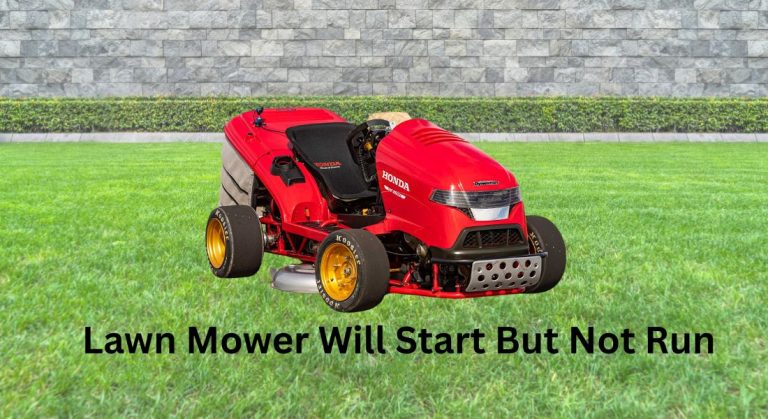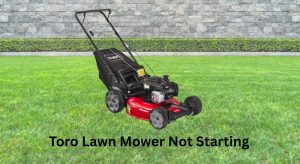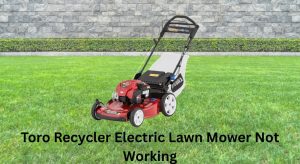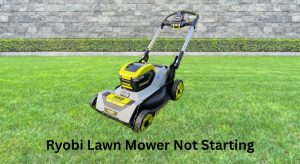If your lawn mower will start but not run, you’re not alone—and it’s incredibly frustrating when it sputters, stalls, or dies a few seconds after starting. The quickest fix is often simple: replace or clean the air filter and use fresh fuel. A dirty filter or stale gas can starve the engine of air or cause poor combustion, leading to stalling.
In this complete guide, you’ll learn the most common causes for a mower that starts then dies and how to fix each—from fuel issues and carburetor clogs to faulty spark plugs and vacuum leaks. We’ll walk through step-by-step methods, preventative tips, and when to call a pro. By the end, you’ll have your mower running smoothly again.
Common Causes When a Lawn Mower Starts Then Dies

- Stale or contaminated fuel
- Clogged carburetor or jets
- Dirty, wet, or blocked air filter
- Flooded engine or incorrect choke setting
- Bad spark plug or weak ignition coil
- Blocked fuel cap vent (vacuum lock)
- Clogged fuel filter or fuel line
- Dirty or sticking carburetor float/needle
- Water in the fuel or carb bowl
- Governor or throttle linkage misadjusted
- Low engine oil causing shutdown (mowers with oil sensor)
- Blade obstruction causing overload
- Grass/debris clogging the deck or cooling fins (overheating)
How to Fix a Lawn Mower That Starts but Won’t Stay Running

Important: Work in a well-ventilated area. Disconnect the spark plug boot before servicing to avoid accidental starts. For engines with fuel shutoff valves, turn it off before removing fuel lines.
Method 1: Quick Checks and Easy Fixes
Diagnosing the Issue
- Does the engine die after 5–30 seconds? Likely fuel delivery or air restriction.
- Does it stall when removing the choke? Carburetor/jets may be clogged.
- Does it surge up and down before dying? Often vacuum/fuel cap vent or jet obstruction.
Fix Steps
1) Replace or clean the air filter (5 minutes)
– Paper filter: Tap gently to remove dust; replace if dark, oily, or torn.
– Foam filter: Wash with mild dish soap and warm water; squeeze dry; lightly oil and reinstall.
– Combination filter: Follow manufacturer guidance.
2) Use fresh fuel (10 minutes)
– Drain the tank and carburetor bowl if fuel is older than 30 days.
– Refill with fresh, ethanol-free fuel if available or add fuel stabilizer.
– For 2-stroke engines, verify proper oil mix ratio (commonly 50:1, 40:1, or 32:1).
3) Check the choke and starting procedure (2 minutes)
– Cold start: Choke ON, start, then move to RUN after 10–30 seconds.
– If it only runs on choke: Carburetor jets are likely clogged.
4) Inspect and replace the spark plug (5 minutes)
– Remove and check for fouling, oil, or carbon.
– Gap to spec (typically 0.020–0.030″) and torque snugly.
– Replace with a new plug if questionable.
5) Loosen the fuel cap while running (1 minute)
– If the mower runs fine with the cap loose, the cap vent is clogged. Replace the cap.
Testing
- Start the mower after each step. If it runs more than 3–5 minutes under load, you likely fixed the issue.
Method 2: Clear Fuel Flow and Replace Filters
Diagnosing the Issue
- Starts then dies or surges; primer bulb stays collapsed; fuel lines look brittle; fuel filter hasn’t been replaced in years.
Fix Steps
1) Verify fuel flow from the tank (10–15 minutes)
– Turn off the fuel valve (if equipped).
– Remove the fuel line at the carb inlet; place line into a container; turn valve on.
– There should be a steady stream. If not, the tank outlet, filter, or line is blocked.
2) Replace the inline fuel filter (5–10 minutes)
– Install in correct flow direction (arrow toward carburetor).
– Replace any cracked or soft fuel lines.
3) Inspect the tank and cap (5 minutes)
– Shine a light into the tank; look for debris or water.
– Drain and rinse with fresh fuel if contaminated.
4) Check for water in the carb bowl (10 minutes)
– Place a rag under the carburetor. Loosen the bowl nut and drain.
– Look for water beads (heavier than gas) and rust. Clean and reinstall.
Testing
- Reconnect and start. If it still only runs on choke or dies at throttle, proceed to carburetor cleaning.
Method 3: Clean the Carburetor and Jets (Most Common Fix)
Engines: Briggs & Stratton, Honda GCV/GC, Kohler, Tecumseh, etc.
Diagnosing the Issue
- Runs only on full choke
- Surges at idle
- Dies under load
- Long storage with ethanol fuel
Fix Steps
1) Remove the carburetor (20–30 minutes)
– Disconnect air filter housing, throttle and choke linkages, and fuel line.
– Take photos for reassembly.
2) Disassemble the carb (15–20 minutes)
– Remove the float bowl, float pin, float, and needle.
– Unscrew the main jet and emulsion tube (often through the center of the bowl nut on B&S).
– Remove idle jet/mixture screw if accessible.
3) Clean thoroughly (15–25 minutes)
– Spray carb cleaner through all passages until it exits elsewhere.
– Use compressed air to blow out jets and ports.
– Do not use metal wire that can enlarge jets; use soft bristles or plastic jet cleaners.
– Replace gaskets, O-rings, and needle if worn.
4) Inspect float and needle (5 minutes)
– Ensure float moves freely and isn’t fuel-logged.
– Verify needle tip isn’t grooved; replace if worn.
5) Reassemble and set (10 minutes)
– Install bowl gasket correctly; ensure no air leaks.
– For adjustable carbs, set mixture screws to base: usually 1.5 turns out from lightly seated.
Alternative: Install a carburetor rebuild kit or a new aftermarket carb (often $15–$40 for many models) if cleaning fails.
Testing
- Start with choke, then move to RUN. Let it idle 2–3 minutes. Engage blades or cut light grass to confirm.
Method 4: Address Ignition and Air/Vacuum Leaks
Diagnosing the Issue
- Random stalling when hot
- Weak/no spark after warm-up
- High idle but dies under load
- Backfiring or popping
Fix Steps
1) Check spark quality (5 minutes)
– Use an inline spark tester. Look for strong, consistent spark.
– Replace spark plug first if weak; then test the ignition coil/module.
2) Inspect coil air gap (5–10 minutes)
– Remove the flywheel shroud.
– Set ignition coil gap to spec using a business card or feeler gauge (commonly 0.010–0.014″).
3) Look for vacuum leaks (10–15 minutes)
– Inspect carb-to-intake and intake-to-block gaskets for cracks.
– Replace any warped gaskets; tighten mounting screws evenly.
– Check primer bulb and lines for splits.
4) Check governor and throttle linkages (10 minutes)
– Ensure springs are intact and connected properly.
– Clean any debris restricting movement; do not overbend springs.
Testing
- Run for 10 minutes with and without load. If it still stalls hot, the ignition coil may be failing when warm—replace it.
Method 5: Fix Overload, Overheating, and Safety Shutdowns
Diagnosing the Issue
- Engine dies when you engage blades
- Stalls in heavy, wet grass
- Shuts down after 5–10 minutes and restarts after cooling
- Low oil shutdown on some engines (especially generators and some mowers)
Fix Steps
1) Inspect the blade and deck (10–15 minutes)
– Disconnect spark plug.
– Remove caked grass from underside of deck.
– Check blade is sharp, straight, and torqued to spec. Replace bent blades.
2) Adjust mowing technique (ongoing)
– Raise the deck height.
– Mow slower, especially in tall or wet grass.
3) Check cooling airflow (10 minutes)
– Remove shroud; blow out debris from fins and around flywheel.
– Clean recoil screen.
4) Verify oil level and type (5 minutes)
– Fill to the proper mark; use recommended viscosity (e.g., SAE 30 for warm weather or 10W-30 for variable temps).
– Some engines will sputter and die if oil is low or foamy.
Testing
- Run under load on a lighter patch first. If it holds, resume normal mowing.
How to Prevent Future Stalling and Running Issues
- Use fresh, stabilized fuel; avoid ethanol when possible.
- Replace air filter and spark plug annually.
- Clean or service carburetor at the start of each season if storage was long.
- Keep the deck and cooling fins clean to prevent overheating.
- Store with empty tank or add stabilizer and run for 5 minutes before winter.
- Replace fuel filter and lines every 2–3 seasons.
Pro Tips
- Add fuel shutoff valve if your mower doesn’t have one—easier storage and carb servicing.
- Use a high-quality stabilizer year-round if fuel sits over 30 days.
- Label your gas can with the date you filled it.
- For Honda-style carbs, don’t forget the tiny idle jet hidden under a rubber plug—commonly missed.
- If it only runs with the gas cap loose, replace the cap—don’t drill holes.
- Ultrasonic cleaner is excellent for stubborn carb varnish.
- Keep a spare spark plug on hand; swapping quickly verifies ignition problems.
When to Call a Professional
- You’ve cleaned the carb and verified good fuel/air/spark but it still dies.
- The ignition coil tests weak when hot, or there are intermittent electrical faults.
- You suspect internal engine issues: low compression, worn rings/valves.
- Persistent fuel leaks from carb or tank.
- Riding mower with safety switch or PTO wiring issues.
Typical costs:
– Carb clean/rebuild: $60–$120
– New carb installed: $80–$160
– Ignition coil replacement: $80–$150
– Diagnostic fee: $50–$100
Warranty:
– If your mower is under warranty, avoid disassembly beyond filters and spark plug. Contact an authorized service center to keep coverage intact.
FAQ
Q: Why does my lawn mower only run on choke?
A: The main jet or emulsion tube in the carburetor is clogged. The choke enriches the mixture enough to compensate. Clean the carburetor and jets or replace the carb.
Q: Can bad gas make a mower start then die?
A: Yes. Ethanol-blended fuel absorbs moisture and degrades within 30 days. Drain old fuel, flush the bowl, and refill with fresh fuel. Use stabilizer to prevent future issues.
Q: How do I know if my gas cap is causing stalling?
A: Loosen the gas cap while running. If the mower runs normally, the cap vent is blocked, creating vacuum lock. Replace the cap.
Q: What if my mower dies when I engage the blades?
A: Check for heavy deck buildup, dull/bent blades, and belt drag (riding mowers). Raise cutting height and inspect for seized pulleys.
Q: The engine stalls after warming up—what’s wrong?
A: Likely ignition coil failure when hot or overheating from clogged cooling fins. Test spark hot, clean fins, and replace the coil if spark is weak or intermittent.
Q: How often should I replace the air filter and spark plug?
A: Replace the air filter every season or 25 hours (clean foam types more often). Replace the spark plug annually or every 100 hours.
Q: Will a clogged fuel filter cause surging?
A: Yes. Restricted fuel flow leads to lean surging and stalling. Replace the filter and inspect lines.
Q: Is it worth rebuilding the carburetor or buying a new one?
A: For many walk-behind mowers, new aftermarket carbs cost $15–$40 and are faster to install. Rebuild if OEM parts are preferred or the carb body is high quality.
Alternatives if Fixes Don’t Work
If your mower is older or suffers repeated carb issues:
– Replace the entire carburetor with a new unit.
– Switch to ethanol-free fuel or premixed alkylate fuel to reduce varnish and moisture issues.
– Consider an electric mower for low maintenance.
| Solution | Pros | Cons | Best For |
|---|---|---|---|
| New carburetor | Fast, reliable fix; inexpensive for many models | May need model-specific match | Recurrent carb clogs |
| Ethanol-free fuel | Better storage stability; cleaner running | Higher cost, less available | Seasonal or infrequent use |
| Electric mower | Minimal maintenance; instant start | Battery cost; runtime limits | Small to medium lawns, convenience |
Get Your Lawn Mower Working Again
By following this guide, you can fix a lawn mower that will start but not run with confidence:
– Replace/clean the air filter and use fresh fuel
– Verify fuel flow and replace the fuel filter
– Clean or replace the carburetor and jets
– Check ignition, fuel cap venting, and vacuum leaks
– Clear deck buildup, ensure proper cooling, and adjust cutting load
Tackle the quick fixes first—they solve most cases in under 30 minutes. With the right steps, you’ll have a smooth, reliable mower and a better-looking lawn in no time.
Have you solved your “lawn mower will start but not run” issue? Share what worked for you to help other readers. Found this helpful? Bookmark it for your next tune-up.





